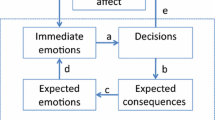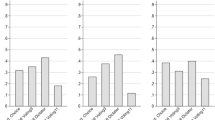Abstract
Using an experimental auction, we explore how verifiable information affects the willingness to pay (WTP) for two climate friendly goods given the politicized climate change debate. We test whether the dissemination of (scientific) verifiable information lets subjects cut through the media noise. We define our baseline by first examining how noisy information (pro and con) about climate change affects WTP. We then consider how third party verifiable information within this noisy information affects WTP. Our results suggest subjects could cut through noisy information to process verifiable information. We find a significant WTP premium for climate protection. The verifiable information treatment increases the premium for both shade-grown coffee (by 51 %) and recycled paper (by 48 %). This suggests the WTP premium for climate change depends on the available information flow and the characteristics of the climate friendly good.





Similar content being viewed by others
Notes
Corbett and Durfee (2004) conduct an experiment and find that reader certainty about climate change is high when a story provides context, and they find that uncertainty is highest when controversy is present. Several papers document that willingness to pay (WTP) tends to be greater for environmentally friendlier products (Essoussi and Linton 2010), and numerous papers report that consumers reveal a positive WTP for environmental friendliness in food production (Baltzer 2003, Corsi and Novelli 2003). Similar results are found for non-food products (Laroche et al. 2001, Vlosky et al. 1999). The literature on how information affects WTP typically focuses on eco-labeling. Studies about eco-labeling indicate that consumers prefer environmentally friendly goods, and they report a significant WTP exists for a premium in environmental products (Diederich and Goeschl, 2014, Kotchen et al. 2013, Achtnicht 2012, Botzen and Van den Bergh, 2012, Loureiro et al. 2002, Johnston et al. 2001, Nimon and Beghin 1999). For instance, Loureiro et al. (2002) report an estimated premium for eco-labeled apples of around 5 %. Aguilar and Vlosky’s (2007) paper is on consumer WTP for price premiums for environmentally certified wood products in the United States, and they report a 10 % WTP premium for certified items. In a similar study, Blend and Van Ravenswaay (1999) report a higher WTP premium for eco-labeled apples—they find a 10 % WTP premium.
This auction mechanism is incentive compatible as each bidder has a weakly dominant strategy to submit a bid that is equal to their private value, and it aims to keep participants engaged in the auction. In a random nth-price auction, the k participants bid their maximum willingness to pay for an item. A monitor collects all bids in envelopes and records the bids in descending order. The monitor then randomly draws a number n from a discrete distribution from 2 to k, and the (n-1) highest bidders pay the nth price. For example, if n = 4 then the three highest bidders pay the fourth highest price.
The monitor determined the binding auction, a, by drawing a random number from 1 to 4. If the binding auction is a multiple good auction, the binding good, g, is determined by drawing a random number from 1 to 2. For example, if a = 3 and g = 2, the binding auction is the coffee auction (3rd auction) and the binding good is the shade coffee (2nd good offered in the coffee auction).
The coefficients are significant at 5 % with a regular variance-covariance matrix (p value = 0.012). We also checked the standards errors with bootstrapping (Mooney and Duval 1993, Cameron and Trivedi 2010), clustering by treatment group, and heteroscedasticity-consistent variances. In all trials, the coefficients are statistically significant at 5 %.
Rousu et al. (2007) consider two socio-demographic variables, gender and income, as the determinants of bidding behavior: they find these variables small in magnitude, although statistically significant. In our study, these demographics are not statistically significant. Including demographics and ordering effect do not change the results.
References
Achtnicht M (2012) German car buyers’ willingness to reduce CO2 emissions. Clim Chang 113:679–697
Aguilar F, Vlosky RP (2007) Consumer willingness to pay price premiums for environmentally certified wood products in the U.S. For Policy Econ 9:1100–1112
Angrist J, Pischke S (2008) Mostly harmless econometrics: an empiricists’ companion. Princeton University Press, Princeton
Baltzer K (2003) Estimating willingness to pay for food quality and safety from actual consumer behavior. Proceedings of the 83rd EAAE Seminar, Chania, 4–6 September, available at: www.maich/eaae.gr
Blackman A, Ávalos-Sartorio B, Chow J. (2008) Land cover change in mixed agroforestry: shade coffee in El Salvador. Resources for the Future (RFF) Discussion Paper No. 08–30
Blend J, Van Ravenswaay E (1999) Consumer demand for Eco-labeled apples: results from econometric estimation. Am J Agric Econ 81:1072–1077
Botzen W, Van den Bergh JCJM (2012) Risk attitudes to low probability climate change risks: WTP for flood insurance. J Econ Behav Organ 82:151–166
Boykoff M, Boykoff J (2004) Balance as bias: global warming and the US prestige press. Glob Environ Chang 14:125–136
Brossard D, Shanahan J, McComas K (2004) Are issue-cycles culturally constructed? A comparison of French and American coverage of climate change. Mass Commun Soc 7:359–377
Cameron A, Trivedi P (2010) Microeconometrics using Stata. Stata Pub Press, College Station
Carson R, Mitchell R (1993) The value of clean water: the public’s willingness to pay for boatable, fishable, and swimmable quality water. Water Resour Res 29:2445–2454
Corbett J, Durfee J (2004) Testing public (un)certainty of science. Sci Commun 26:129–151
Corsi A, Novelli S (2003) Consumers’ willingness to pay a price for organic beef meat, paper presented at the EAAE Congress, Zaragoza, August 28–31
Dagnes A (2010) Politics on demand: the effects of 24-hour news on American politics. Praeger, Santa Barbara
Diederich J, Goeschl T (2014) Willingness to pay for voluntary climate action and its determinants: field-experimental evidence. Environ Resour Econ 57:405–429
Environmental Protection Agency (EPA) (2006) Solid waste management and greenhouse gases: a life-cycle assessment of emissions and sinks. Staff Report
Essoussi L, Linton J (2010) New or recycled products: how much are consumers willing to pay? J Consum Mark 27:5
Huang J, Haab T, Whitehead J (1997) Willingness to pay for quality improvements: should revealed and stated preference data be combined? J Environ Econ Manag 34:240–255
Huffman W, Tegene A (2002) Public acceptance of and benefits from agricultural biotechnology: A key role for verifiable information. Market development for genetically modified good (V Santaniello, R Evenson, D Zilberman, eds). Oxfordshire, UK: CAB International, 179–190
Johnson E, Nemet G (2010) Willingness to pay for climate change policy: A review of studies, La Follette School Working Paper No.2010–011
Johnston R, Wessells C, Donath H, Asche F (2001) Measuring consumer preferences for ecolabeled seafood: an international comparison. J Agric Resour Econ 26:20–39
Kotchen M, Boyle K, Leiserowitz A (2013) Willingness to pay and policy instrument choice for climate change policy in the United States. Energy Policy 55:617–625
Laroche M, Bergeron J, Barbaro-Forleo G (2001) Targeting consumers who are willing to pay more for environmentally friendly products. J Consum Mark 18:503–520
Loureiro M, McCluskey J, Mittelhammer R (2002) Will consumers pay a premium for Eco-labeled apples? J Consum Aff 36:203–219
Lusk J, Shogren J (2007) Experimental auctions: methods and applications in economic and marketing research. Cambridge University Press, UK
McConnell K (1990) Models for referendum data: the structure of discrete choice models for contingent valuation. J Environ Econ Manag 18:19–34
Mooney C, Duval R (1993) Bootstrapping: a nonparametric approach to statistical inference. Sage Publications, Newbury Park
Nelkin D (1995) Selling science. Freeman, New York
Nimon W, Beghin J (1999) Are eco-labels valuable? Evidence from the apparel industry. Am J Agric Econ 81:801–811
Ray J, Pugliese A. (2011) Worldwide, blame for climate change falls on humans. <http://probeinternational.org/library/wp-content/uploads/2011/04/Gallup-Poll-Worldwide-Blame-for-Climate-Change-Falls-on-Humans.pdf>
Rousu M, Huffman W, Shogren J, Tegene A (2007) Effects and value of verifiable information in a controversial market: evidence from lab auctions of genetically modified food. Econ Inq 45:409–432
Schelling T (1992) Some economics of global warming. Am Econ Rev 82:1–14
Shogren J, Toman M (2000) Climate change policy. Public policies for environmental protection 2nd ed. (P Portney, R Stavins, Eds.). Resources for the Future, Washington, DC
Shogren J, Margolis M, Koo C, List J (2001) A random nth-price auction. J Econ Behav Organ 46:409–421
Vlosky R, Ozanne L, Fontenot R (1999) A conceptual model of US consumer willingness-to-pay for environmentally certified wood products. J Consum Manag 16:122–136
Whitehead J (1995) Willingness to pay for quality improvements: comparative statics and interpretation of contingent valuation results. Land Econ 71:207–215
Acknowledgments
We thank the Stroock (University of Wyoming) and the Rasmuson funds (University of Alaska-Anchorage) for the partial financial support. Thanks to Matt Rousu and the reviewers for helpful comments.
Author information
Authors and Affiliations
Corresponding author
Electronic supplementary material
ESM 1
(DOCX 218 kb)
Rights and permissions
About this article
Cite this article
Sapci, O., Wood, A.D., Shogren, J.F. et al. Can verifiable information cut through the noise about climate protection? An experimental auction test. Climatic Change 134, 87–99 (2016). https://doi.org/10.1007/s10584-015-1502-3
Received:
Accepted:
Published:
Issue Date:
DOI: https://doi.org/10.1007/s10584-015-1502-3




